“[W]e are in a very key, transformative period with respect to racial change in the United States,” said Senior Fellow William Frey today during an event to discuss the findings and implications of his new book, Diversity Explosion: How New Racial Demographics Are Remaking America. Frey said that in the year 2050, “people are going to look back at this period and call it the pivotal period of demographic change in the United States.”
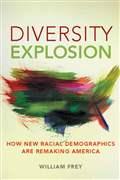 During the presentation, Frey—an internationally recognized demographer and scholar in the Metropolitan Policy Program at Brookings—presented his main findings, including how the U.S. population is diversifying from the bottom up, how the white population is aging and declining, and what the implications of these changes are for the economy and politics. The conversation continued in a Q&A with Ron Brownstein, editorial director of Atlantic Media and long-time observer of U.S. politics, and Senior Fellow Amy Liu, co-director of the Metropolitan Policy Program.
During the presentation, Frey—an internationally recognized demographer and scholar in the Metropolitan Policy Program at Brookings—presented his main findings, including how the U.S. population is diversifying from the bottom up, how the white population is aging and declining, and what the implications of these changes are for the economy and politics. The conversation continued in a Q&A with Ron Brownstein, editorial director of Atlantic Media and long-time observer of U.S. politics, and Senior Fellow Amy Liu, co-director of the Metropolitan Policy Program.
Visit the event’s page for a complete video recording. Highlights of the data presented and discussion appear below.
2044: The year the Census Bureau projects we’ll have more minorities than whites in the U.S.
Frey explained that the rapid growth of new minorities—Hispanics, Asians, and multi-racial persons—combined with the slow growth and aging of the white population mean that whites will no longer be a majority of the U.S. population. Moreover, he said, “in about ten years we’ll have an absolute decline in the nation’s white population.”
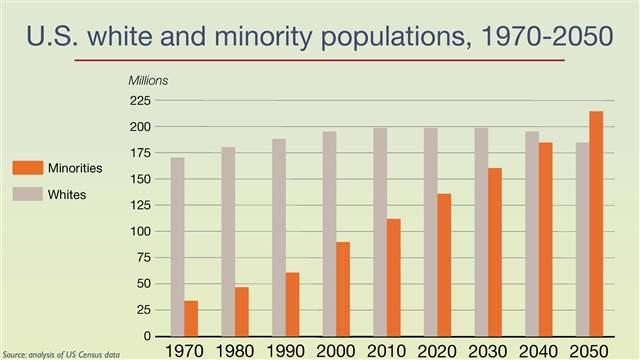
Frey added that the natural increase of minority populations (due in large part, he said, to the fact that it’s a much younger population, especially Hispanics) is especially important “because it’s happening just in time to counter this decline in the white population” and will “help us in all kinds of ways.”
2020: The year by which everyone under age 18 will be majority-minority
Also, by the year 2027, everyone under age 30 will be majority-minority. Frey used these data to highlight what he calls a “cultural generation gap,” in which the younger population that is becoming more diverse, and the older population that is increasingly white and declining, do not seem to share the same social and political outlook. For example, older white people may be less favorable to public services and taxes that benefit the younger generation.
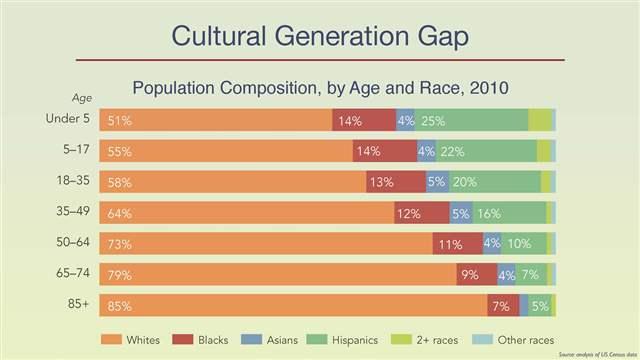
During the discussion that followed Frey’s presentation, Brownstein addressed this issue of a gap between the younger and older generations, especially in politics. “I completely agree with the underlying conclusion,” he said, “that there is more common interest between these two generations than our politics allows, because ultimately to support the retirement safety net that the baby boom needs we have to do a better job at moving more of this future workforce into the middle class.” But, he continued:
[T]hat’s not where our politics is today. Our politics today is that we are living through an overlapping generational, racial, and geographic realignment that is leaving us with two coalitions that are utterly divergent in who they represent, where they live, and what they want.
I described our coalitions essentially today as separate but equal coalitions. The reality is that no Democratic presidential candidate since Lyndon Johnson has won a majority of whites. Since 1988, the total variation in the Democratic share among white voters has been between 38 percent and 44 percent according to the exit polls.
Brownstein elaborated that in 2008 Barack Obama was the first candidate to lose whites by double digits yet still won, and that he lost whites by 20 points to Mitt Romney in 2012 and still won, due to his large share of the minority vote. “Every Democratic nominee since 1976,” said Brownstein, “has won between 78 and 82 percent of the combined minority vote.”
Half of U.S. counties showing declines in their white populations
Frey showed that about half of the over 3,000 counties in the United States are now experiencing declines in their white populations, counties both in the heartland but also in large metro areas. At the same time, traditional “melting pot” states with large immigrant populations—e.g., California, Illinois, Florida, Texas, New York—are no longer the only places in America where diversity is spreading. Hispanic populations, for example, are growing in nearly 200 metros throughout the country.
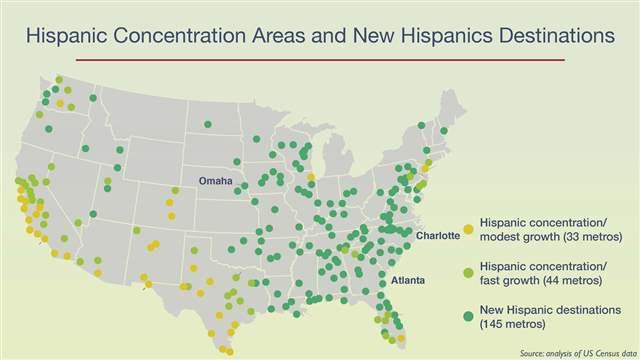
1960: 0.4 percent of marriages were multiracial / 2008-10: 15.2 percent were
Another way to understand the demographic changes, Frey explained, is to look at the increase in multi-racial marriages. In addition to the massive increase in the share of marriages classified as multi-racial, Frey noted that one of four new marriages among Hispanics and Asians are multi-racial, while one of eight total marriages among the black population are black-white marriages.
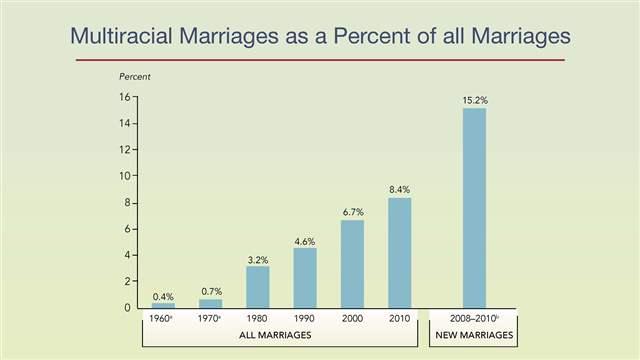
Is population change due to immigrants?
Frey addressed one popular explanation for the rapid rise of minority populations in the United States: immigration, new entrants into the U.S. population. But that is a different discussion, he said. Frey explained that “irrespective of what our immigration is going to be in the future … this diversity explosion is still going to occur because it’s already embedded in our population, it’s already embedded in our demography.” Calling immigration “a false argument” when thinking about the youth population, he instead emphasized that “Immigrant integration is something we should be paying attention to, the children of immigrants who are already here.”
Optimism for the Future
Frey emphasized three issues as we look to the future:
- The need “to pay huge attention to the next generations’ minorities in the United States,” through providing education, pathways to the middle class, job training, “and the right kind of both federal and local support” to help their families.
- The need to “pay attention to new destinations” for minorities. Frey said we have to be “proactive” about understanding that new minorities are moving to places where perhaps they haven’t been before, but “we can plan for this.”
- The need to “close the cultural generation gap in the United States.” Frey said that communities and the nation need to understand the consequences of the fact that, increasingly, the older generation and younger generation seem to vote much differently.
Frey expressed optimism, citing a number of factors, including interracial dating and marriage among younger people; the historical DNA of the “melting pot” idea in our country; the “globalization of commerce and communication”; and, finally, the demographic transformation itself. On this point, Frey was emphatic:
The most important reason why I think that we’re going to change in the future and be open to racial diversity is this sharp demographic transformation that we’re undergoing. When the civil rights laws were passed in the 1960s, only 15 percent of the population were racial minorities and they were mostly blacks and they were mostly living in segregated cities. When the 2020 Census is taken, more than 40 percent of the population are going to be racial minorities. They are going to be voting, they are going to be running for office themselves, they are going to become established members of different industries and different communities. And I think when we get to that stage, there is so much that people are going to understand, not just in clusters somewhere else but moving to all parts of the country, that they are going to understand that they have to take this seriously.
Brownstein also expressed optimism for the future, despite the gap observed earlier between the young, increasingly diverse population and the older, largely white population. The “biggest thing that is a course of optimism,” he said, “is awareness in the business and civic community that this is the future workforce,” leading to cities and communities developing their own programs to address the needs of the rising generation.
In terms of opportunity, Frey linked it to demography:
I think opportunity will become linked with demography once all of the people—both on the Democratic side of the aisle, all the nonprofit groups, all the union groups, all of the people who are fighting very hard to have economic opportunity—get to tell the rest of the population what the demographic situation is going to be. That they are not going to have their Social Security unless they do something about these younger people. So I think these demographic forces will give fuel to those arguments.
Learn more about the event here, and learn more about Diversity Explosion here.
The Brookings Institution is committed to quality, independence, and impact.
We are supported by a diverse array of funders. In line with our values and policies, each Brookings publication represents the sole views of its author(s).


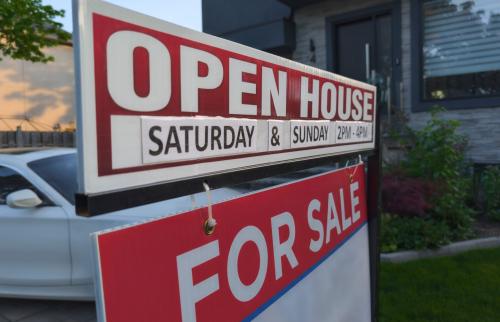
Commentary
U.S. Diversity Explosion Is a Reason for Optimism
December 15, 2014